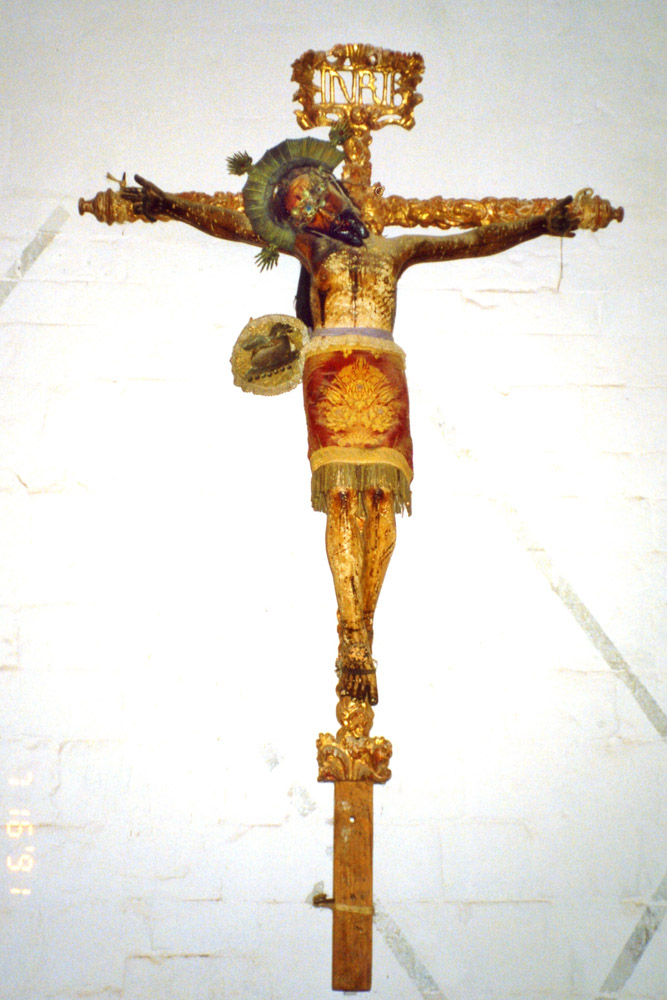Crucifix 4:
On the scutum is a metal cut-out with the
lamb and book of John the Evangelist. The crown of thorns
is set with "jewels." The blood at the feet has been
applied in such a way as to suggest its having been
splattered as the nail went through. Some of the ribs are
painted on. Several fingers are missing. The gold
crosspieces are elaborated carved. Set atop the vertical
piece is a carved gilt frame for the "INRI" letters, which
are carved.
Local Name: El Señor de la
Misericordia.
Basis for Identification: Red
embroidered loincloth with scutum, cruciform halo with
crown of thorns, skinned knees, wound in side, flowing
blood, INRI plaque.
Site: Museum of Santo
Domingo Yanhuitlán.
Location: East
wall of the convento museum (see note).
Media and construction: Wood,
gesso, paint, fabric loincloth and
scutum. Eyes: painted. Hair: wig.
Sculpted teeth and tongue.
Size: About 9 feet (275 cm.)
Comparable santos in Oaxaca: Achiutla,
Santa Ana del
Valle1, Santa Ana del
Valle2, Santa Ana del
Valle3, Cuilapan,
Etla, Guelavia,
Mitla, Nochixtlán,
Tamazulapan1,
Tamazulapan2,
Teitipac1,
Teitipac2,
Teitipac3,
Teitipac
Our Lady of the Rosary, Teotitlán1, Teotitlán2, Teposcolula1,
Teposcolula2,
Teposcolula3
(in Rosary case), Teposcolula
Convento1, Teposcolula
Convento2, Tilantongo1,
Tilantongo2,
Tlacolula1,
Tlacolula2,
Xoxocotlán1, Xoxocotlán2, Xoxocotlán3, Xoxocotlán4, Yanhuitlán1, Yanhuitlán2, Yanhuitlán
Convento1, Yanhuitlán
Convento2, Yanhuitlán
Convento3, Yanhuitlán
Convento5, Yanhuitlán
Ayuxi Chapel, Zimatlán.
External Links:
Wikimedia Commons:
Crucifixes
in
Mexico
Catholic Encyclopedia: Archaeology
of the Cross and Crucifix
Wikipedia: Crucifix
Christian Iconography: The
Crucifixion
Next: The fifth crucifix
on the east wall
Previous santo
Introduction
to the Museum at Yanhuitlán
Santos Home Page
Note: On
this
site,
references to the cardinal directions in a church
always assume that the main altar is at the east end
of the church, the narthex or entry area at the west
end, and the two walls
of the nave on the
north and south. (The
nave is the long central section.)
In Yanhuitlán, this schema extends the four
directions to the Museum. That is, "east" means
parallel to the east side of the church, "south"
to the south side, etc. Actual orientations may
differ.
The photo shown here is licensed under the
Creative Commons Attribution-Share Alike 3.0 Unported
license. You are free to share or remix it on two
conditions: first, that you attribute it to the
photographers, Claire and Richard Stracke, without
implying any approval of your work on their part;
second, that if you alter, transform, or build upon
this photo, you may distribute the resulting work only
under the same or similar license to this one.
|


